2000 NISSAN FRONTIER light
[x] Cancel search: lightPage 30 of 269
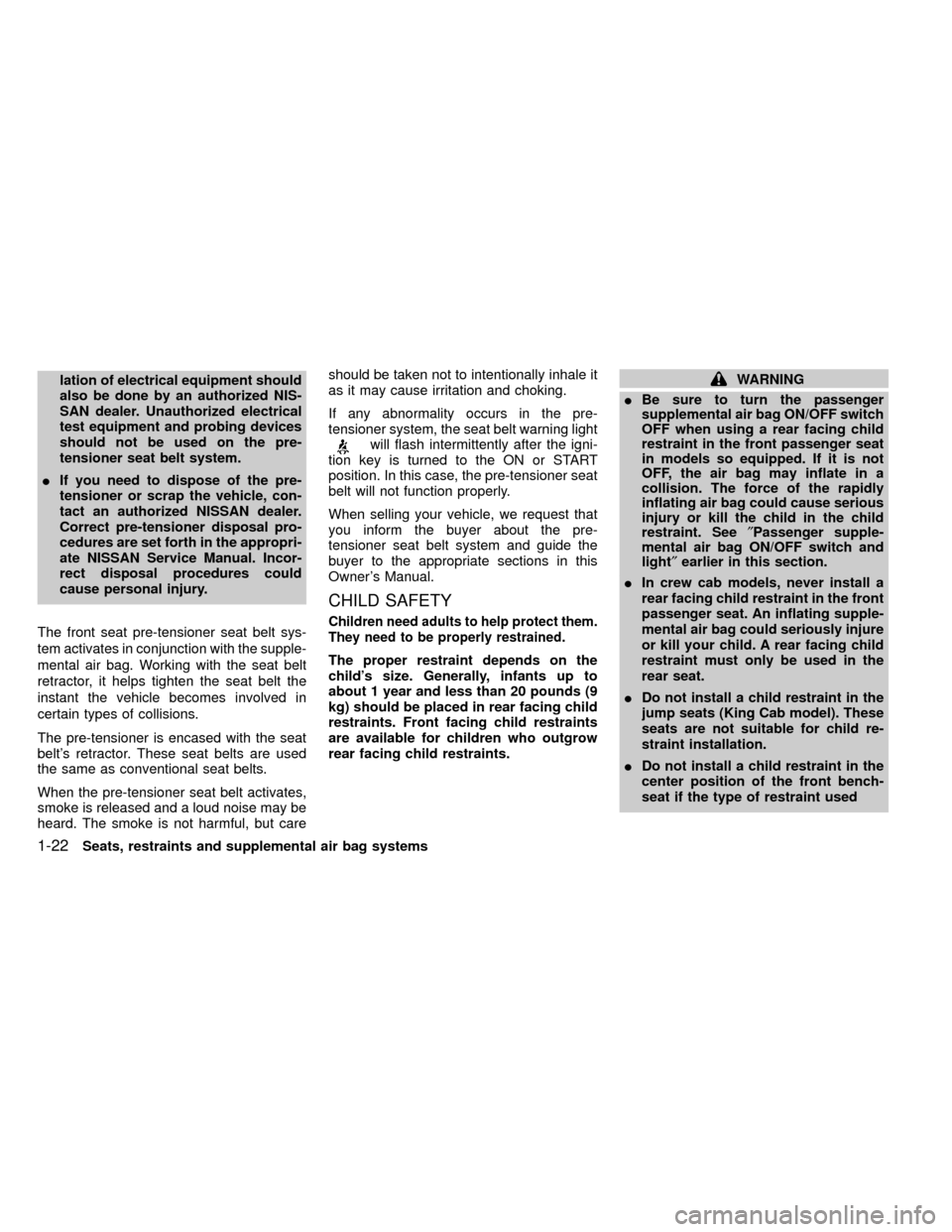
lation of electrical equipment should
also be done by an authorized NIS-
SAN dealer. Unauthorized electrical
test equipment and probing devices
should not be used on the pre-
tensioner seat belt system.
IIf you need to dispose of the pre-
tensioner or scrap the vehicle, con-
tact an authorized NISSAN dealer.
Correct pre-tensioner disposal pro-
cedures are set forth in the appropri-
ate NISSAN Service Manual. Incor-
rect disposal procedures could
cause personal injury.
The front seat pre-tensioner seat belt sys-
tem activates in conjunction with the supple-
mental air bag. Working with the seat belt
retractor, it helps tighten the seat belt the
instant the vehicle becomes involved in
certain types of collisions.
The pre-tensioner is encased with the seat
belt's retractor. These seat belts are used
the same as conventional seat belts.
When the pre-tensioner seat belt activates,
smoke is released and a loud noise may be
heard. The smoke is not harmful, but careshould be taken not to intentionally inhale it
as it may cause irritation and choking.
If any abnormality occurs in the pre-
tensioner system, the seat belt warning light
will flash intermittently after the igni-
tion key is turned to the ON or START
position. In this case, the pre-tensioner seat
belt will not function properly.
When selling your vehicle, we request that
you inform the buyer about the pre-
tensioner seat belt system and guide the
buyer to the appropriate sections in this
Owner's Manual.
CHILD SAFETY
Children need adults to help protect them.
They need to be properly restrained.
The proper restraint depends on the
child's size. Generally, infants up to
about 1 year and less than 20 pounds (9
kg) should be placed in rear facing child
restraints. Front facing child restraints
are available for children who outgrow
rear facing child restraints.
WARNING
IBe sure to turn the passenger
supplemental air bag ON/OFF switch
OFF when using a rear facing child
restraint in the front passenger seat
in models so equipped. If it is not
OFF, the air bag may inflate in a
collision. The force of the rapidly
inflating air bag could cause serious
injury or kill the child in the child
restraint. See²Passenger supple-
mental air bag ON/OFF switch and
light²earlier in this section.
IIn crew cab models, never install a
rear facing child restraint in the front
passenger seat. An inflating supple-
mental air bag could seriously injure
or kill your child. A rear facing child
restraint must only be used in the
rear seat.
IDo not install a child restraint in the
jump seats (King Cab model). These
seats are not suitable for child re-
straint installation.
IDo not install a child restraint in the
center position of the front bench-
seat if the type of restraint used
1-22Seats, restraints and supplemental air bag systems
ZX
Page 31 of 269
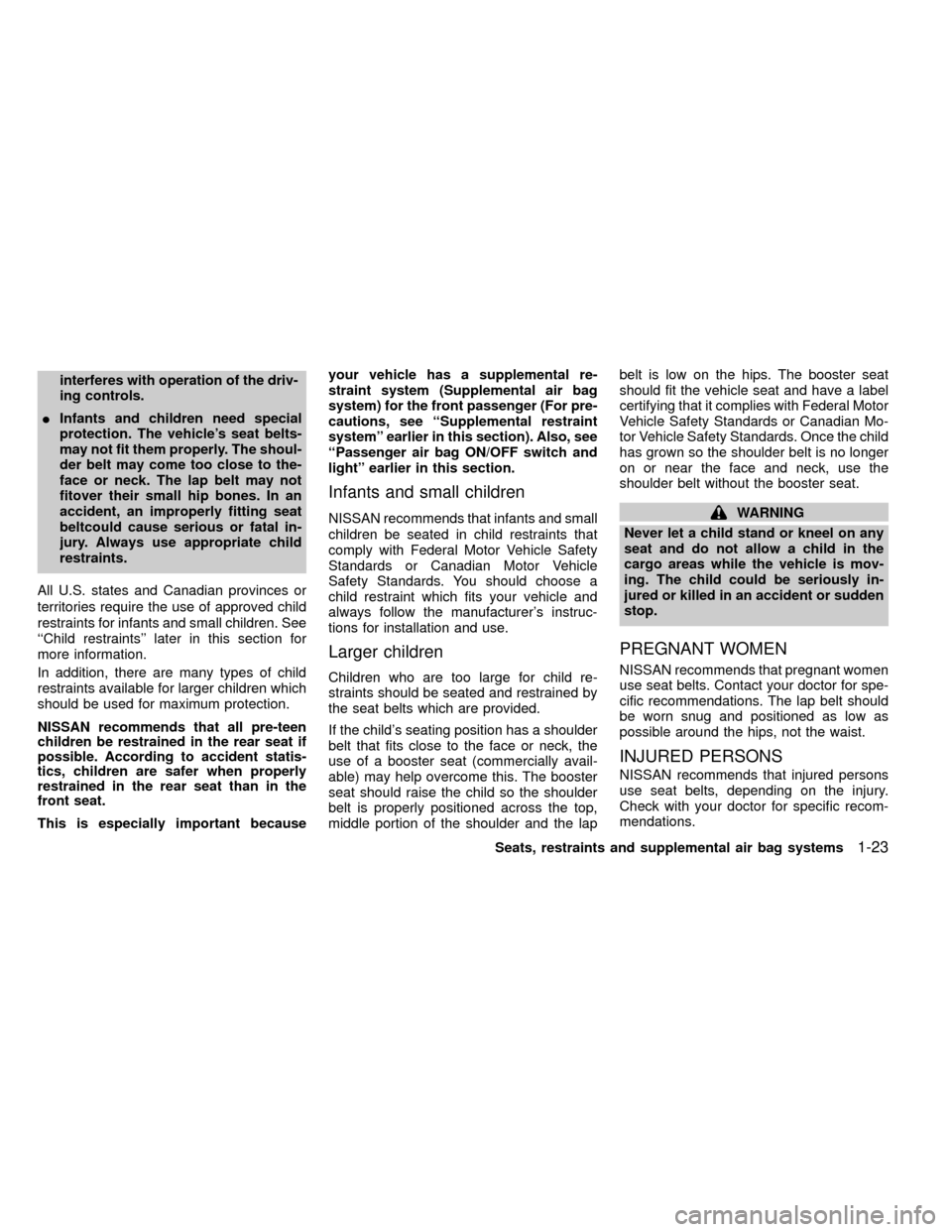
interferes with operation of the driv-
ing controls.
IInfants and children need special
protection. The vehicle's seat belts-
may not fit them properly. The shoul-
der belt may come too close to the-
face or neck. The lap belt may not
fitover their small hip bones. In an
accident, an improperly fitting seat
beltcould cause serious or fatal in-
jury. Always use appropriate child
restraints.
All U.S. states and Canadian provinces or
territories require the use of approved child
restraints for infants and small children. See
``Child restraints'' later in this section for
more information.
In addition, there are many types of child
restraints available for larger children which
should be used for maximum protection.
NISSAN recommends that all pre-teen
children be restrained in the rear seat if
possible. According to accident statis-
tics, children are safer when properly
restrained in the rear seat than in the
front seat.
This is especially important becauseyour vehicle has a supplemental re-
straint system (Supplemental air bag
system) for the front passenger (For pre-
cautions, see ``Supplemental restraint
system'' earlier in this section). Also, see
``Passenger air bag ON/OFF switch and
light'' earlier in this section.
Infants and small children
NISSAN recommends that infants and small
children be seated in child restraints that
comply with Federal Motor Vehicle Safety
Standards or Canadian Motor Vehicle
Safety Standards. You should choose a
child restraint which fits your vehicle and
always follow the manufacturer's instruc-
tions for installation and use.
Larger children
Children who are too large for child re-
straints should be seated and restrained by
the seat belts which are provided.
If the child's seating position has a shoulder
belt that fits close to the face or neck, the
use of a booster seat (commercially avail-
able) may help overcome this. The booster
seat should raise the child so the shoulder
belt is properly positioned across the top,
middle portion of the shoulder and the lapbelt is low on the hips. The booster seat
should fit the vehicle seat and have a label
certifying that it complies with Federal Motor
Vehicle Safety Standards or Canadian Mo-
tor Vehicle Safety Standards. Once the child
has grown so the shoulder belt is no longer
on or near the face and neck, use the
shoulder belt without the booster seat.
WARNING
Never let a child stand or kneel on any
seat and do not allow a child in the
cargo areas while the vehicle is mov-
ing. The child could be seriously in-
jured or killed in an accident or sudden
stop.
PREGNANT WOMEN
NISSAN recommends that pregnant women
use seat belts. Contact your doctor for spe-
cific recommendations. The lap belt should
be worn snug and positioned as low as
possible around the hips, not the waist.
INJURED PERSONS
NISSAN recommends that injured persons
use seat belts, depending on the injury.
Check with your doctor for specific recom-
mendations.
Seats, restraints and supplemental air bag systems
1-23
ZX
Page 38 of 269

SEAT BELT MAINTENANCE
ITo clean the seat belt webbings,apply
a mild soap solution or any solution
recommended for cleaning upholstery or
carpet. Then wipe with a cloth and allow
the seat belts to dry in the shade. Do not
allow the seat belts to retract until they
are completely dry.
IIf dirt builds up in the shoulder belt
guideof the seat belt anchors, the seat
belts may retract slowly. Wipe the shoul-
der belt guide with a clean, dry cloth.
I
Periodically check to see that the seat
belt and the metal components,such
as buckles, tongues, retractors, flexible
wires and anchors, work properly. If
loose parts, deterioration, cuts or other
damage on the webbing is found, the
entire seat belt assembly should be re-
placed.
WARNING
IInfants and small children should
always be placed in an appropriate
child restraint while riding in the ve-
hicle. Failure to use a child restraint
can result in serious injury or death.
IInfants and small children should
never be carried on your lap. It is not
possible for even the strongest adult
to resist the forces of a severe acci-
dent. The child could be crushed
between the adult and parts of the
vehicle. Also, do not put the sameseat belt around both your child and
yourself.
IIn crew cab models, never install a
rear facing child restraint in the front
passenger seat. An inflating supple-
mental air bag could seriously injure
or kill your child. A rear facing child
restraint must only be used in the
rear seat.
INever install a rear-facing child re-
straint in the front seat of a model
equipped with a supplemental air
bag ON/OFF switch unless you first
turn OFF the air bag. An inflating air
bag could seriously injure or kill
your child. See ``Passenger supple-
mental air bag ON/OFF switch and
light'' earlier in this section.
IAn improperly installed child re-
straint could lead to serious injury or
death in an accident.
IIn general, child restraints are de-
signed to be installed with a lap belt
or the lap portion of a three-point
type seat belt.
INissan recommends that the child
restraint be installed in the rear seat.
ARS1098
CHILD RESTRAINTS
1-30Seats, restraints and supplemental air bag systems
ZX
Page 40 of 269

IWhen your child restraint is not in
use, keep it secured with a seat belt
to prevent it from being thrown
around in case of a sudden stop or
accident.
CAUTION
Remember that a child restraint left in a
closed vehicle can become very hot.
Check the seating surface and buckles
before placing your child in the child
restraint.
FRONT FACING INSTALLATION
ON FRONT PASSENGER SEAT
(Three-point type with retractor)
WARNING
IIf so equipped, keep the passenger
supplemental air bag ON/OFF switch
turned ON unless a rear-facing child
restraint is used in the front seat. If
the switch is OFF, the air bag will not
inflate in a collision as designed.INISSAN recommends that child re-
straints be installed in the rear seat.
However, if you must install a
forward-facing child restrain in the
front passenger seat, move the pas-
senger seat to the rear most posi-
tion.
INever install a rear facing child re-
straint in the front seating position
of crew cab models. Install a rear
facing child restraint in the rear seat
only. The force of the inflating air
bag could cause serious injury or kill
the child in the child restraint.
IThe three-point belt in your vehicle
is equipped with a locking mode re-
tractor which must be used when
installing a child restraint.
IFailure to use the retractor's locking
mode will result in the child restraint
not being properly secured. The re-
straint could tip over or otherwise be
unsecured and cause injury to the
child in a sudden stop or collision.
I
If the supplemental air bag warning
light located in the instrument panel
ARS1109
1-32Seats, restraints and supplemental air bag systems
ZX
Page 41 of 269
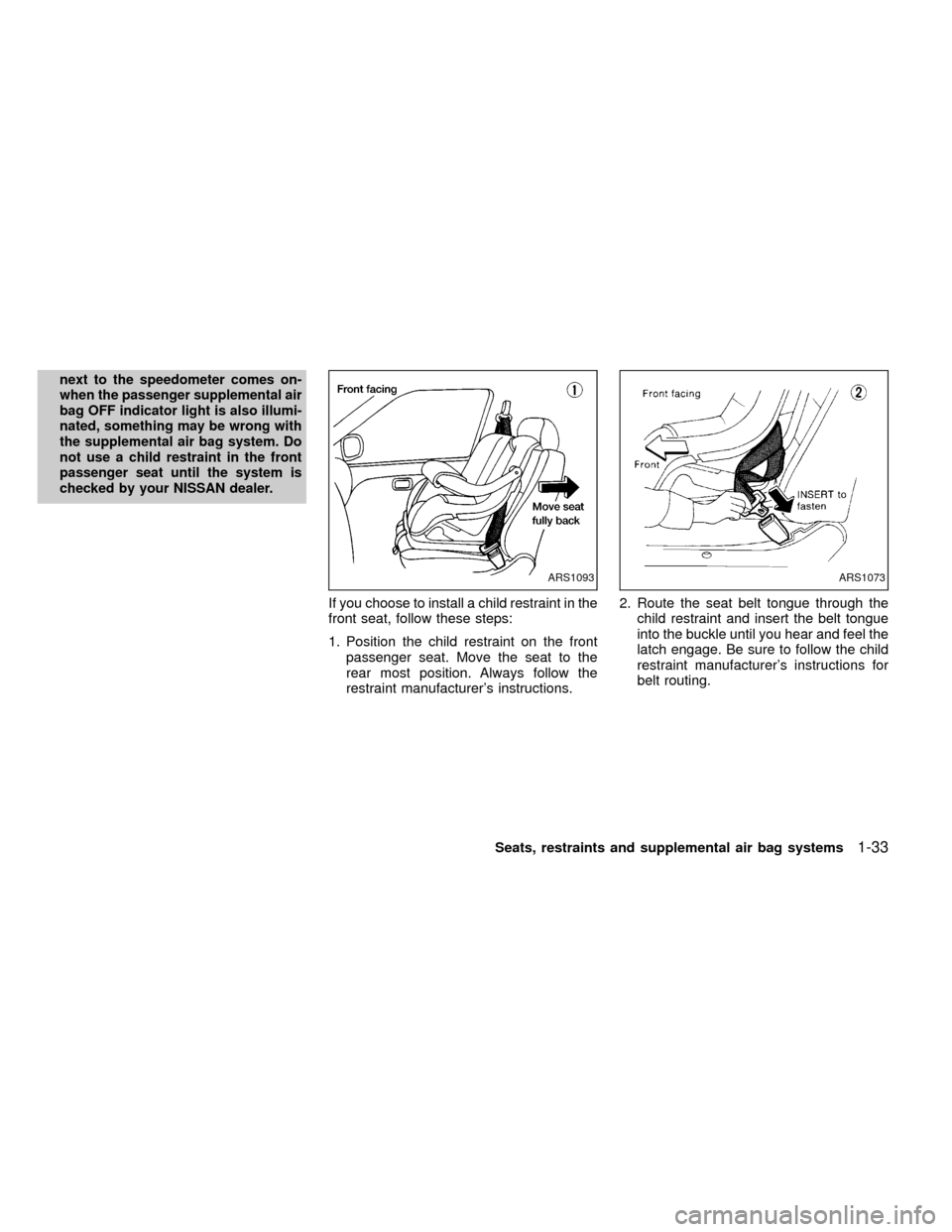
next to the speedometer comes on-
when the passenger supplemental air
bag OFF indicator light is also illumi-
nated, something may be wrong with
the supplemental air bag system. Do
not use a child restraint in the front
passenger seat until the system is
checked by your NISSAN dealer.
If you choose to install a child restraint in the
front seat, follow these steps:
1. Position the child restraint on the front
passenger seat. Move the seat to the
rear most position. Always follow the
restraint manufacturer's instructions.2. Route the seat belt tongue through the
child restraint and insert the belt tongue
into the buckle until you hear and feel the
latch engage. Be sure to follow the child
restraint manufacturer's instructions for
belt routing.
ARS1093ARS1073
Seats, restraints and supplemental air bag systems1-33
ZX
Page 43 of 269
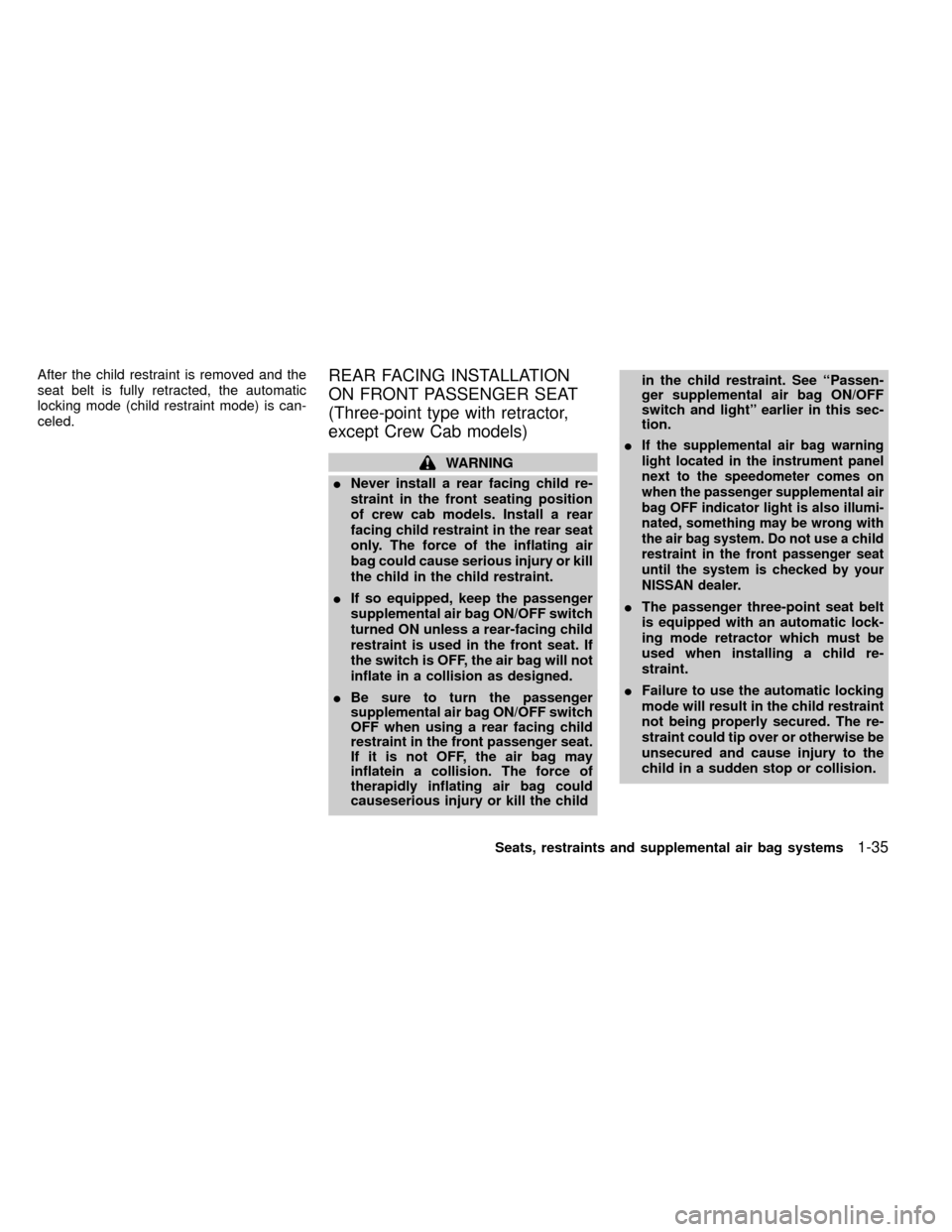
After the child restraint is removed and the
seat belt is fully retracted, the automatic
locking mode (child restraint mode) is can-
celed.REAR FACING INSTALLATION
ON FRONT PASSENGER SEAT
(Three-point type with retractor,
except Crew Cab models)
WARNING
INever install a rear facing child re-
straint in the front seating position
of crew cab models. Install a rear
facing child restraint in the rear seat
only. The force of the inflating air
bag could cause serious injury or kill
the child in the child restraint.
IIf so equipped, keep the passenger
supplemental air bag ON/OFF switch
turned ON unless a rear-facing child
restraint is used in the front seat. If
the switch is OFF, the air bag will not
inflate in a collision as designed.
IBe sure to turn the passenger
supplemental air bag ON/OFF switch
OFF when using a rear facing child
restraint in the front passenger seat.
If it is not OFF, the air bag may
inflatein a collision. The force of
therapidly inflating air bag could
causeserious injury or kill the childin the child restraint. See ``Passen-
ger supplemental air bag ON/OFF
switch and light'' earlier in this sec-
tion.
I
If the supplemental air bag warning
light located in the instrument panel
next to the speedometer comes on
when the passenger supplemental air
bag OFF indicator light is also illumi-
nated, something may be wrong with
the air bag system. Do not use a child
restraint in the front passenger seat
until the system is checked by your
NISSAN dealer.
IThe passenger three-point seat belt
is equipped with an automatic lock-
ing mode retractor which must be
used when installing a child re-
straint.
IFailure to use the automatic locking
mode will result in the child restraint
not being properly secured. The re-
straint could tip over or otherwise be
unsecured and cause injury to the
child in a sudden stop or collision.
Seats, restraints and supplemental air bag systems
1-35
ZX
Page 55 of 269
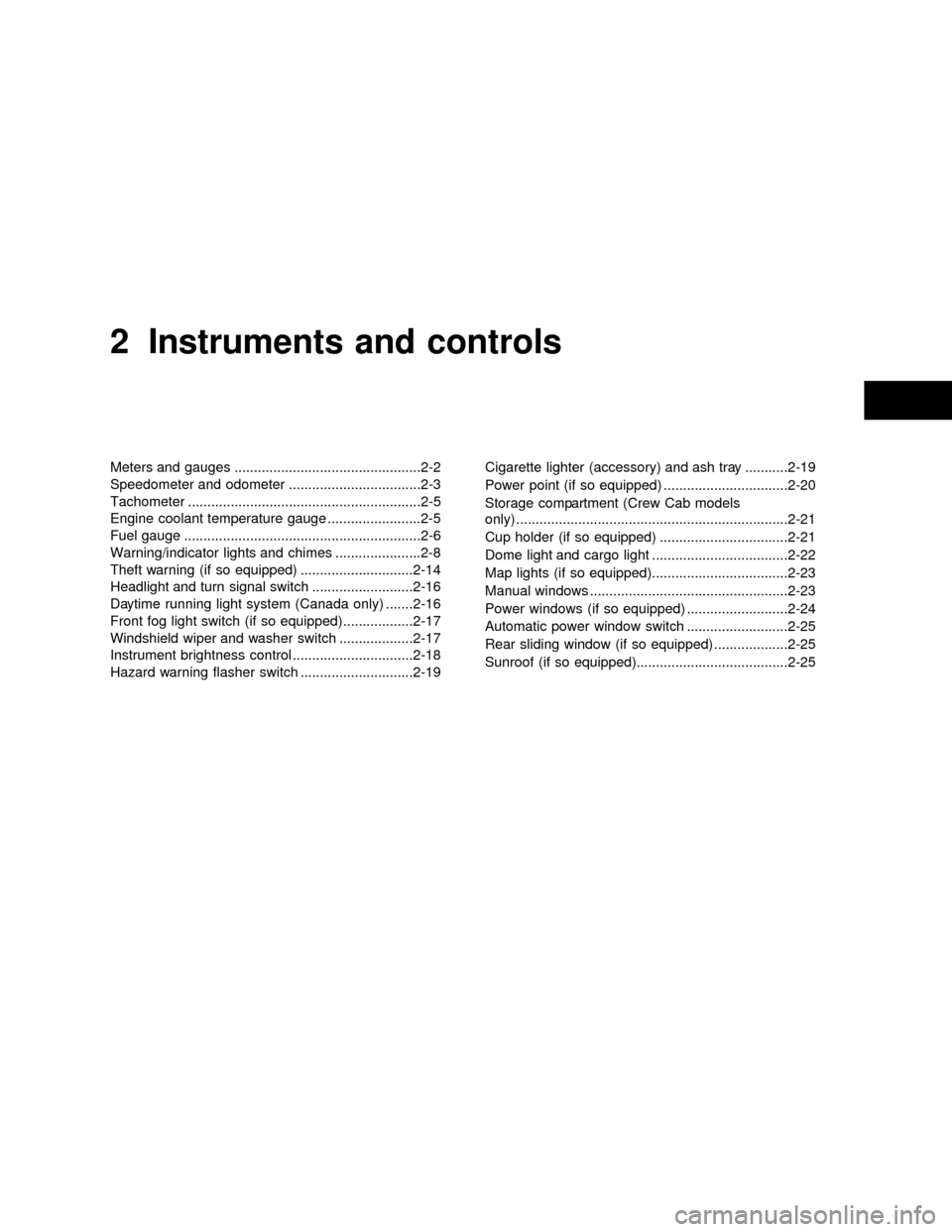
2 Instruments and controls
Meters and gauges ................................................2-2
Speedometer and odometer ..................................2-3
Tachometer ............................................................2-5
Engine coolant temperature gauge ........................2-5
Fuel gauge .............................................................2-6
Warning/indicator lights and chimes ......................2-8
Theft warning (if so equipped) .............................2-14
Headlight and turn signal switch ..........................2-16
Daytime running light system (Canada only) .......2-16
Front fog light switch (if so equipped)..................2-17
Windshield wiper and washer switch ...................2-17
Instrument brightness control ...............................2-18
Hazard warning flasher switch .............................2-19Cigarette lighter (accessory) and ash tray ...........2-19
Power point (if so equipped) ................................2-20
Storage compartment (Crew Cab models
only) ......................................................................2-21
Cup holder (if so equipped) .................................2-21
Dome light and cargo light ...................................2-22
Map lights (if so equipped)...................................2-23
Manual windows ...................................................2-23
Power windows (if so equipped) ..........................2-24
Automatic power window switch ..........................2-25
Rear sliding window (if so equipped) ...................2-25
Sunroof (if so equipped).......................................2-25
ZX
Page 61 of 269
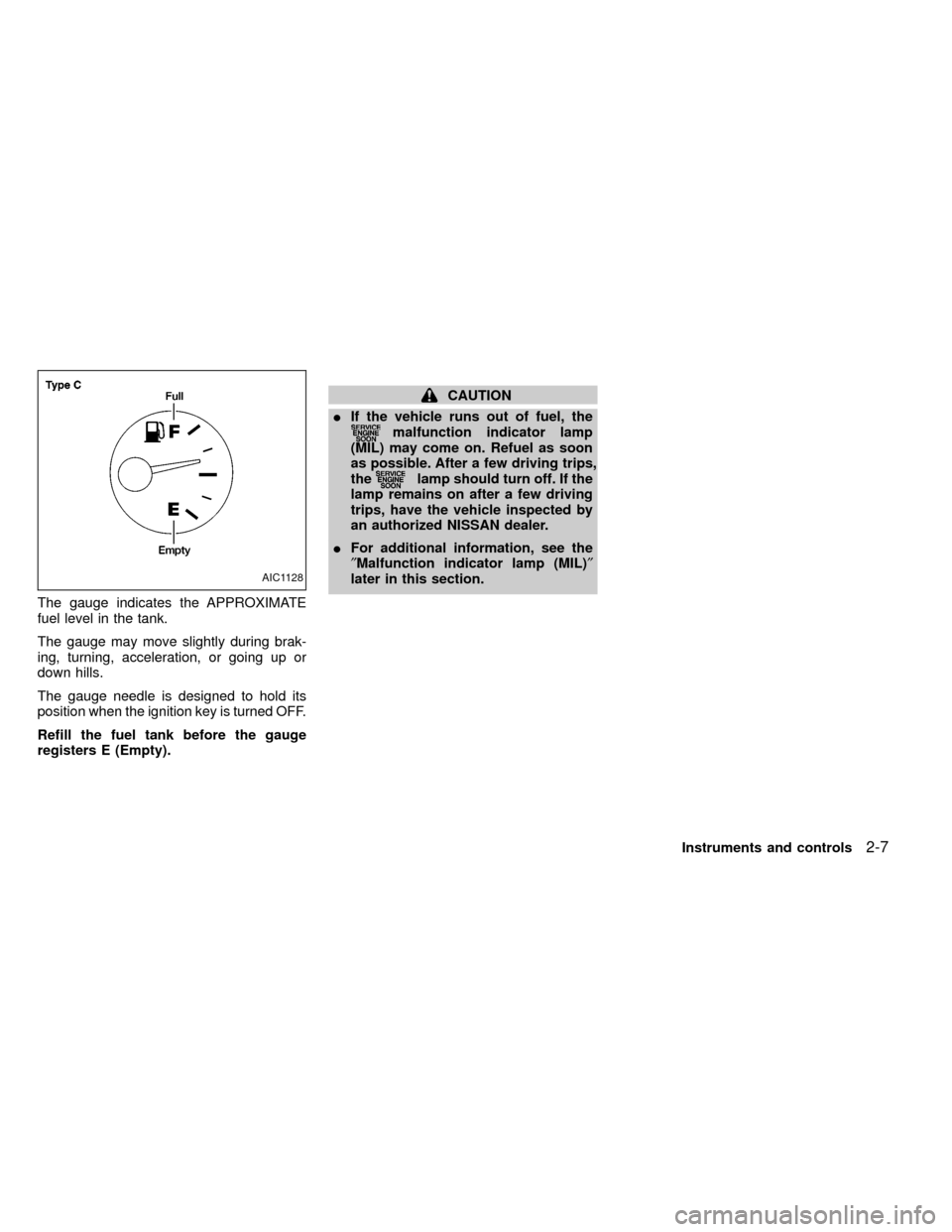
The gauge indicates the APPROXIMATE
fuel level in the tank.
The gauge may move slightly during brak-
ing, turning, acceleration, or going up or
down hills.
The gauge needle is designed to hold its
position when the ignition key is turned OFF.
Refill the fuel tank before the gauge
registers E (Empty).
CAUTION
IIf the vehicle runs out of fuel, the
malfunction indicator lamp
(MIL) may come on. Refuel as soon
as possible. After a few driving trips,
the
lamp should turn off. If the
lamp remains on after a few driving
trips, have the vehicle inspected by
an authorized NISSAN dealer.
IFor additional information, see the
²Malfunction indicator lamp (MIL)²
later in this section.
AIC1128
Instruments and controls2-7
ZX